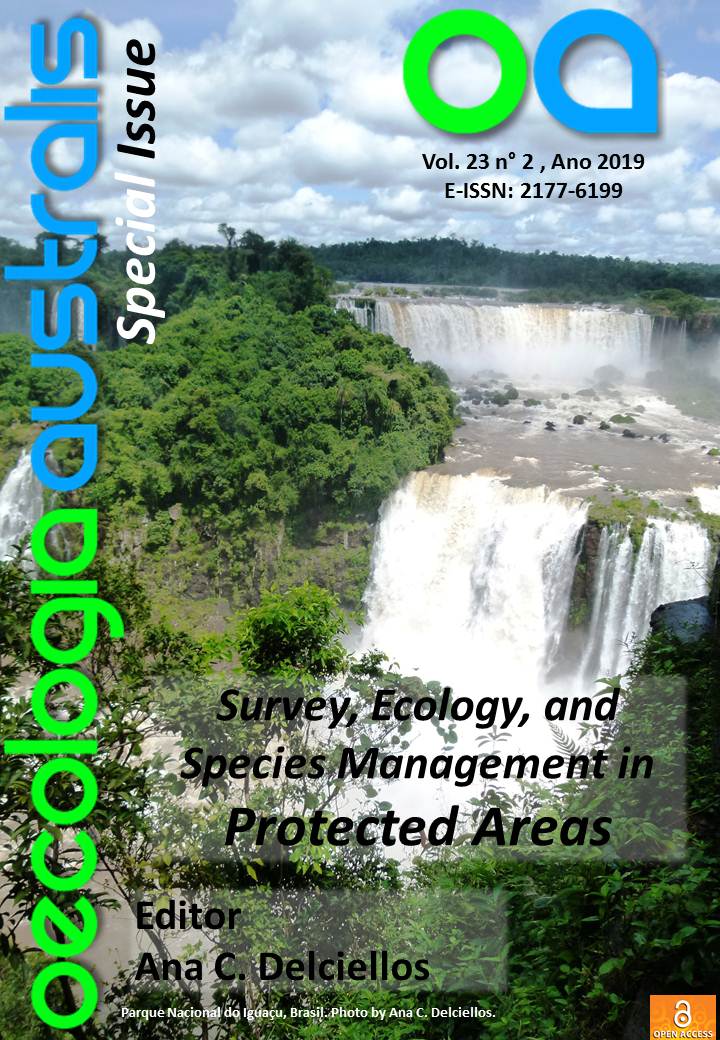A 3-YEAR POPULATION STUDY OF Guerlinguetus brasiliensis ingrami (RODENTIA, SCIURIDAE) AT THE SERRA DA BOCAINA NATIONAL PARK, RIO DE JANEIRO STATE, BRAZIL
DOI:
https://doi.org/10.4257/oeco.2019.2302.14Keywords:
Atlantic Forest, Brazilian squirrel, MNKA, POPAN, protected areaAbstract
The Brazilian Squirrel Guerlinguetus brasiliensis ingrami (Rodentia, Sciuridae) is commonly observed in the wild, yet its population parameters are poorly known because this species is rarely captured with traditional live-traps. Here we evaluated the population parameters of G. b. ingrami in a 3-year capture-mark-recapture study at the Serra da Bocaina National Park, Rio de Janeiro state, Brazil. Population parameters were evaluated using the Jolly-Seber model POPAN and the Minimum Number Known to be Alive (MNKA). Population size estimates ranged between 3.2 ± 2.4 (mean ± SE) and 51.3 ± 15.0 individuals based on POPAN, and 2 and 10 individuals based on MNKA. Our population density estimates (1.3 to 74.3 individuals/km2)were similar to those documented in previous studies carried out in the Atlantic Forest. Monthly survival was high (0.94 ± 0.02) and capture probability was low (0.16 ± 0.05), probably reflecting the species trap-shyness. The low capture probability of G. b. ingrami evidences the importance of the unique population data presented in this study for increasing basic knowledge on this species.
Downloads
References
Alvarenga, C. A., & Talamoni, S. A. 2005. Nests of the Brazilian squirrel Sciurus ingrami Thomas (Rodentia, Sciuridae). Revista Brasileira de Zoologia, 22(3), 816–818. DOI: 10.1590/S0101-81752005000300048
Anton, J. R. I., Rotger, A., Igual, J. M., & Tavecchia, G. 2014. Estimating lizard population density: an empirical comparison between line-transect and capture–recapture methods. Wildlife Research, 40(7), 552-560. DOI: 10.1071/WR13127
Bordignon, M. O. 2014. Captura e observação de esquilos no Brasil. In: N. R. Reis, A. L. Peracchi, B. K. Rossaneis & M. N. Fregonezi (Eds.), Técnicas de estudos aplicadas aos mamíferos silvestres brasileiros. pp. 183-191. Rio de Janeiro: Technical Books Editora.
Bordignon, M., & Monteiro-Filho, E. L. 2000. Behaviour and daily activity of the squirrel Sciurus ingrami in a secondary araucaria forest in southern Brazil. Canadian Journal of Zoology, 78(10), 1732–1739. DOI: 10.1139/z00-104
Burnham, K. P., & Anderson, D. R. 2002. Model selection and multimodel inference: a practical information-theoretic approach. New York: Springer Science & Business Media.
Carothers, A. D. 1979. Quantifying unequal catchability and its effect on survival estimates in an actual population. The Journal of Animal Ecology, 43(8), 863–869. DOI: 10.2307/4199
Chiarello, A. G. 2000. Density and population size of mammals in remnants of Brazilian Atlantic forest. Conservation Biology, 14(6), 1649–1657. DOI: 10.1111/j.1523-1739.2000.99071.x
De Vivo, M., & Carmignotto, A. P. 2015. Family Sciuridae G. Fischer, 1817. In: J. L. Patton, U. F. J. Pardiñas, & G. D’Elía (Eds.), Mammals of South America, volume 2: Rodents. pp. 1–48. Chicago and London: The University of Chicago Press.
Dice, L. R. 1938. Some census methods for mammals. The Journal of Wildlife Management, 2(3), 119-130. DOI: 10.2307/3796432
Eckrich, C. A., Flaherty, E. A., & Ben-David, M. 2018. Functional and numerical responses of shrews to competition vary with mouse density. PloS one, 13(1), e0189471. DOI: 10.1371/journal.pone.0189471
Ferreguetti, A. C., Tomas, W. M., & Bergallo, H. G. 2016. Abundância e densidade de mamíferos de médio e grande porte na Reserva Natural Vale. In: S. G. Rolim, L. F. T. Manezes & A. C. Srbek-Araujo (Eds.), Floresta Atlântica de tabuleiro: diversidade e endemismos na Reserva Natural Vale. pp. 453–465. Belo Horizonte: Editora Rupestre.
Galetti, M., Brocardo, C. R., Begotti, R. A., Hortenci, L., Rocha‐Mendes, F., Bernardo, C. S. S., Bueno, R. S., Nobre, R., Bovendorp, R. S., Marques, R. M., Meirelles, F., Gobbo, S. K., Beca, G., Schmaedecke, G., & Siqueira, T. 2017. Defaunation and biomass collapse of mammals in the largest Atlantic forest remnant. Animal Conservation, 20(3), 270–281. DOI: 10.1111/acv.12311
Google Inc. 2018. Google Earth Pro version 7.3.1.4507.
Helder-José, Zortéa, M., Passamani, J. A., Mendes, S. L., & Passamani, M. 2016. Mammals from Duas Bocas Biological Reserve, state of Espírito Santo, Brazil. Boletim do Museu de Biologia Mello Leitão, 38(2), 163–180.
Krebs, C. J. 1966. Demographic changes in fluctuating populations of Microtus californicus. Ecological Monographs, 36(3), 239–73. DOI: 10.2307/1942418
Lurz, P. W., Gurnell, J., & Magris, L. 2005. Sciurus vulgaris. Mammalian species, 769, 1–10. DOI: 10.1644/1545-1410(2005)769[0001:SV]2.0.CO;2
Mendes, C. P., & Cândido-Jr, J. F. 2014. Behavior and foraging technique of the Ingram's squirrel Guerlinguetus ingrami (Sciuridae: Rodentia) in an Araucaria moist forest fragment. Zoologia, 31(3), 209–214. DOI: 10.1590/S1984-46702014000300001
Merrick, M. J., Koprowski, J. L., & Gwinn, R. N. 2012. Sciurus stramineus (Rodentia: Sciuridae). Mammalian Species, 44(1), 44–50. DOI: 10.1644/894.1
Nitikman, L. Z. 1985. Sciurus granatensis. Mammalian Species, 246(1), 1–8. DOI: 10.2307/3503822
Pacheco, M., Kajin, M., Gentile, R., Zangrandi, P.L., Vieira, M.V., & Cerqueira, R. 2013. A comparison of abundance estimators for small mammal populations. Zoologia, 30, 182–190. DOI: 10.1590/S1984-46702013000200008
Passamani, M., & Fernandez, F. A. S. 2011. Abundance and richness of small mammals in fragmented Atlantic Forest of southeastern Brazil. Journal of Natural History, 45(9–10), 553–565. DOI: 10.1080/00222933.2010.534561
Ribeiro, L. F., Conde, L. O. M., & Tabarelli, M. 2010. Predação e remoção de sementes de cinco espécies de palmeiras por Guerlinguetus ingrami (Thomas, 1901) em um fragmento urbano de floresta Atlântica montana. Revista Árvore, 34(4), 637–649.
Schwarz, C. J., & Arnason, A. N. 1996. A general methodology for the analysis of capture-recapture experiments in open populations. Biometrics, 52(3), 860–87. DOI: 10.2307/2533048
Schwarz, C. J., & Arnason, A. N. 2018. Chapter 12: Jolly-Seber models in MARK. In: E. Cooch & G. White (Eds.), Program MARK: a gentle introduction. 17th edition. pp. 1-51. http://www. phidot. org/software/mark/docs/book/
Sikes R. S., & Animal Care and Use Committee of the American Society of Mammalogists. 2016. Guidelines of the American Society of Mammalogists for the use of wild mammals in research and education. Journal of Mammalogy, 97, 663–88.
White, G. C., & Burnham, K. P. 1999. Program MARK: survival estimation from populations of marked animals. Bird Study, 46(1), 120–139. DOI: 10.1080/00063659909477239
Williams, B. K., Nichols, J. D. & Conroy, M. J. 2002. Analysis and Management of Animal Populations. Academic Press, San Diego, CA.


